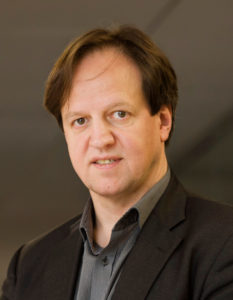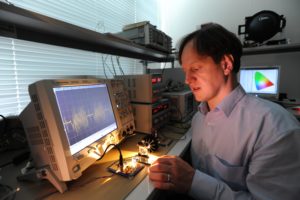Professor Harald Haas
Humboldt Research Award

My research areas:
I have been working in wireless communications for the past 27 years. My career started at Siemens Semiconductors (now Infineon) in a team that developed the first GSM (Global System for Mobile Communications) chipset for Siemens Mobile. My research interests have since have been centred on new enabling technologies for mobile communication systems. This includes new multiple input multiple output (MIMO) transmission techniques such as spatial modulation which we introduced 2006. In the past twenty years, my research focus has gradually shifted away radio frequency (RF) to optical wireless communications. We are now working with partners on new optical sources such as micro light emitting diodes (LEDs), laser light, various solar cell technologies as simultaneous energy harvesters and gigabit per second data receivers and new wireless paradigms such as reconfigurable intelligent surfaces (RIS) for optical wireless systems. In a UK national 6G research project Terabit per second (Tbps) Optical Wireless System (TOWS) we are currently developing key technologies for wireless networks that can deliver aggregate data rates of more than a Tbps in a mobile multiuser scenario.
Home University / Research Institute:
I am Distinguished Professor at the University of Strathclyde / Glasgow and a Visiting Professor at the University of Edinburgh
Host research group:
The research group of Professor Schober, IDC
Research period at the Faculty of Engineering, FAU:
I plan to conduct research with Professor Schober and his team for a total period of 9-12 months over a period of three years between 2022 and 2024.
What is the focus of your research during your visit?

The content of the research collaboration is centered on 6G: It is generally accepted that to achieve step-change improvements in net-zero, data rates, latency, user experience and coverage (overcoming the digital divide is particularly important post Covid), radically new solutions are required for 6G. Specifically, there are three areas in which we will collaborate:
- We will collaborate on THz communications (300 GHz – 10 THz) as well as optical wireless communications (10 THz – 1 PHz).
- Our intention is to advance reconfigurable intelligent surfaces (RIS) for all potential 6G frequency bands.
- We will work on point-to-point free space optical (FSO) communications to provide an effective solution to the digital divide.
I choose FAU because:
Of its national and international reputation as a research-intensive and leading university. It is an absolute privilege to collaborate with Prof. Schober who is among the top researchers in wireless communications in the world.
Further information
Prof. Dr.-Ing. Robert Schober